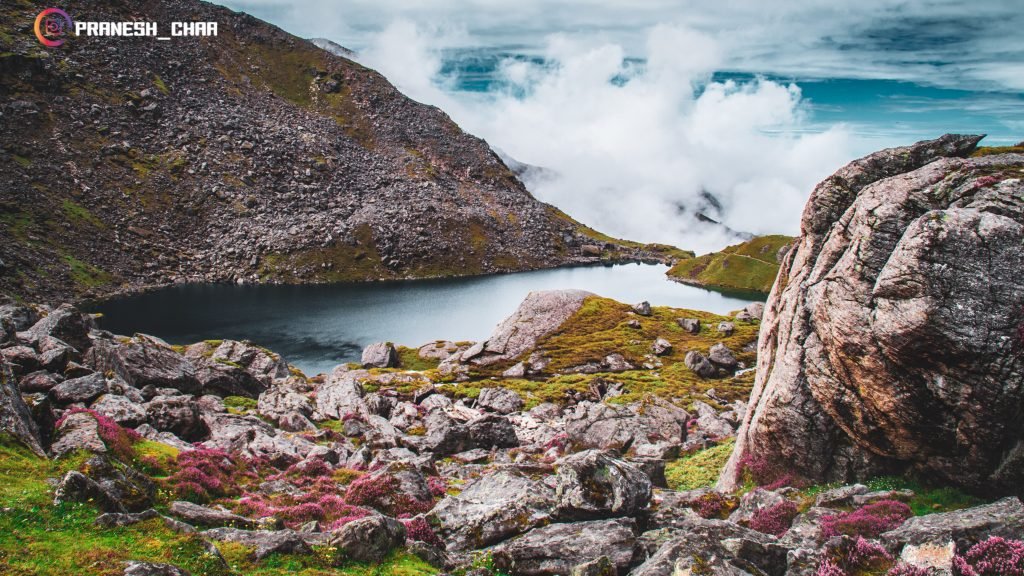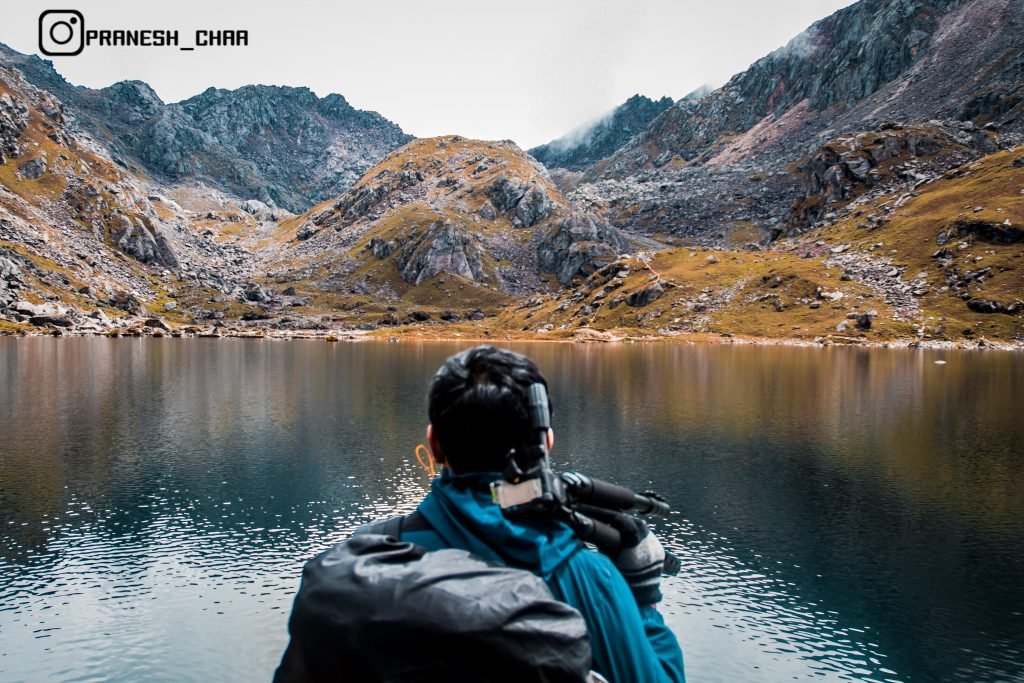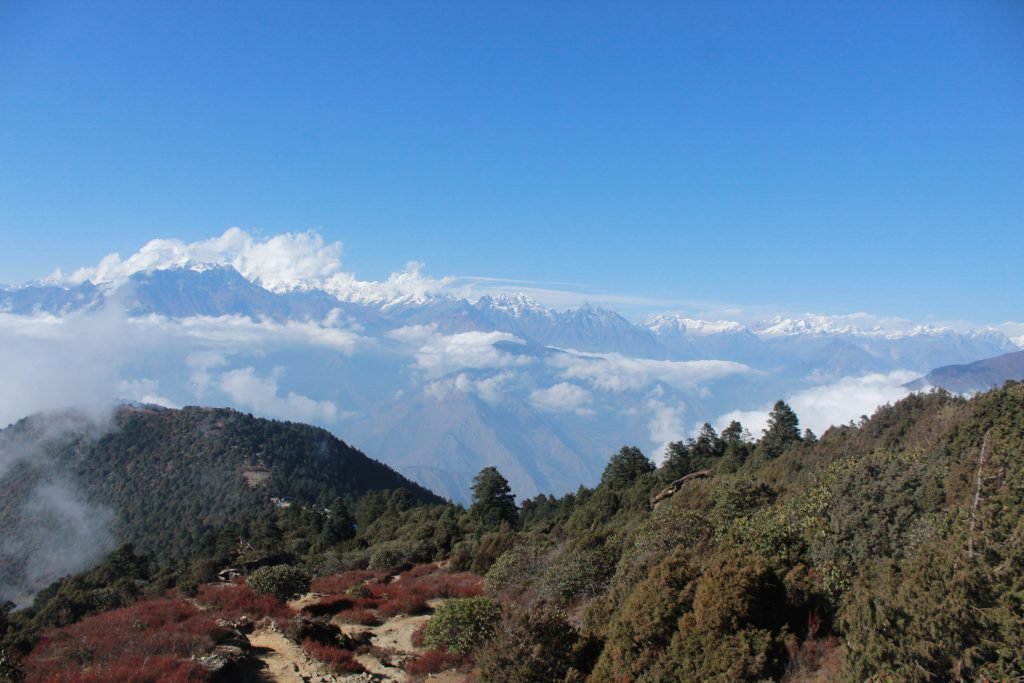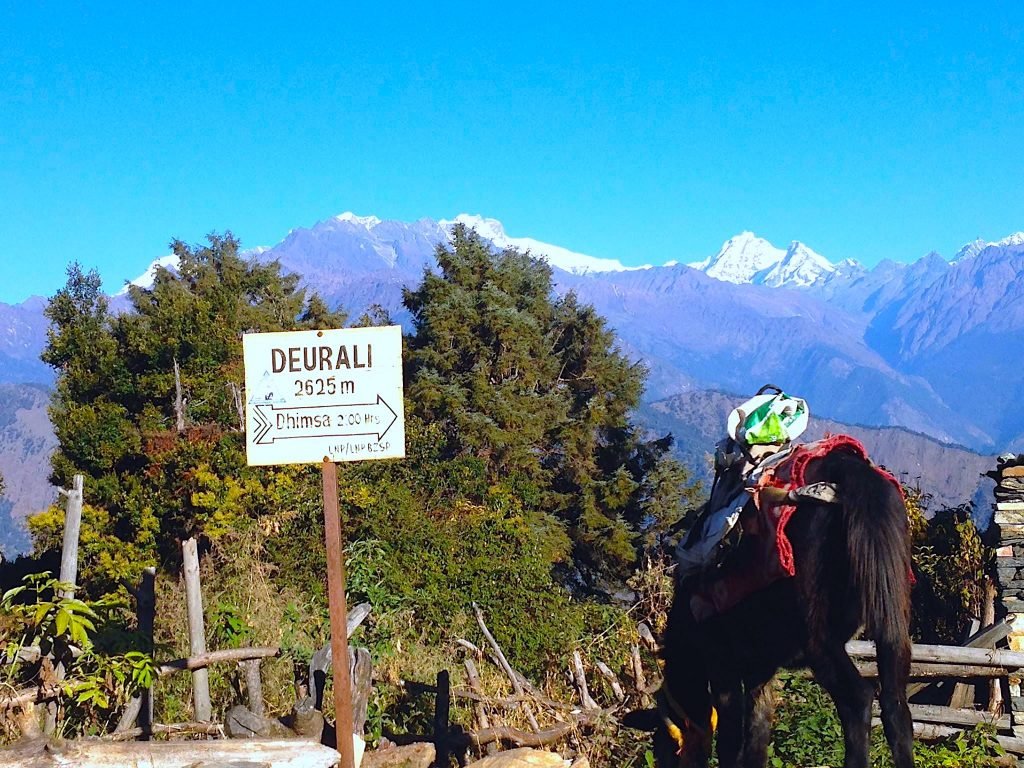The myth behind the formation of Gosainkunda Lake is more than enough for any travel enthusiast to be intrigued to see and know more about this spiritual heaven. It is said that Lord Shiva, one of the most predominant and celebrated gods in Hindu culture formed this lake. After drinking poison from Samudra Manthan, in pain, he started bashing his Trishul (three-pointed weapon) on the very ground where Dudhkunda, Suryakunda, and Bhairabkunda are located. In a lot of suffering and agony, it is said that he created more than 100 other smaller lakes like Gosainkunda in the area, but what makes Gosainkunda so prominent from other lakes in the same region? Is it the beauty? Is it the size? Actually, to ease his pain caused by the poison, Lord Shiva specifically drank the water from one of those hundreds of lakes which today is popularly known as Gosainkunda. Pilgrims and devotees claim to have seen the image of a lying Shive on the button of the lake. So, Gosainkunda holds a very significant cultural and touristic importance.
This is a trekking destination with a difference, a natural paradise, a place to heal, learn and come in touch with your spiritual self. This is one of the perfect nature and culture based trekking destinations of what Nepal as a country has to offer. Experience the rich Tamang culture and diverse natural richness of Gosainkunda trek.
Overview
<p><b>Starting Trek point: Dhunche</b></p>
<p><b>Ending Trek point: Mulkharka</b></p>
<p><b>Highest altitude to gain: Laurebina La (4,610 m)</b></p>
<p><b>Difficulty: 3.5 out of 5</b></p>
<p><b>Seasons to avoid trekking here: Mid-June to August (Monsoon season)</b></p>
Itinerary
Altitude information: Kathmandu (1,400 m)
Your arrival will be awaited by our representatives at the Tribhuvan International Airport (TIA). You will be transferred to the hotel rooms in the city along with your luggage. You will meet the trekking team, guide and representatives for trek briefs and you will have all the freedom to prepare yourself for the trek.
Overnight in Kathmandu
Lunch, breakfast and dinner included
Altitude information: Kathmandu (1,400 m), Dhunche (2,030 m)
We started our journey early in the morning to Dhunche, the administrative headquarters of Rasuwa district and the gateway to Gosainkunda. The drive might be bumpy at times as our vehicle caresses through the curvy hills gifting us with picturesque views of lush green hills.
Overnight in Dhunche
Lunch, breakfast and dinner included
Altitude information: Dhunche (2,030 m), Deurali (2,500 m), Dhimsa (2,900 m), Chandanbari (3,300 m)
This is where the real fun begins. For the first 30 to 45 minutes we walk through a quite populated area of Dhunche settlement but as we walk further, we enter the forest leading us to our first bridge of this trek. The wooden bridge built over a gently flowing stream is the first of many nature’s offerings that you will see throughout the trek.
After we cross the bridge, it is all an uphill walk but this walk will be like no other as you pass through the heart of the forest. The trekking route is full of greenery all year round. Wildflowers, wild mushrooms, pine trees, numerous species of birds along this trail. This region is also home to the endangered red pandas.
We reach Deurali after a steep ascent. Deurali only has one hotel. It is located on top of a hill and on a misty day the view in Deurali is as magical as it can get. After a short water break in Deurali, we ascend more, go deeper into the forest until we reach Chandanbari, our resting place for the day.
Overnight in Chandanbari
Lunch, breakfast and dinner included
Altitude information: Chandanbari (3,300 m), Chholangpati (3,500 m), Laurebinayak (3,900 m), Gosainkunda (4,380 m)
After a healthy breakfast, the initial climb consists of deep forests and an uphill walk. This continues until we reach Chholangpati, where there are two tea houses.
The best thing about reaching Chholangpati is the trail beyond this point. It is a gradual uphill and comparatively easy walk until we reach Laurebina. All this climb is worth it as you will witness the pristine Langtang Himalayan range at a close distance. The cinematic reveal of Langtang range, Ganesh Himal (7,400 m), Manaslu (8,156 m), Himchuli (7,893 m) is the reward a traveler would long for. After a short break here we head towards the sacred Gosainkunda lake.
After reorganizing we climb again. But this time we leave the lush green forests behind and walk on the barren fields along with the magical mountain ranges. The wind is harsher here so comfy multilayered caps are recommended to protect your head. We push on and on the way, we will see a big waterfall signifying we are almost there. The narrow trail ends and after descending a few meters we see Dudhkunda, another lake right by the side of Gosainkunda. The emerald-colored Dudhkunda lake is as alluring as Gosainkunda. A short walk from Dudhkunda is the holy lake of Gosainkunda in all its glory. Once we are in Gosainkunda it’s all about enjoying and celebrating our success.
Overnight in Gosainkunda
Lunch, breakfast and dinner included
Altitude information: Gosainkunda (4,380 m), Laurebina La (4,610 m), Bhera Goth (4,240 m), Suryakunda Phedi (3,470 m), Dhupichaur (3,630 m), Ghopte Vir (3,440m)
We will be trekking further and higher today, but will rest at a lower altitude. There is one more lake, Surya Kunda at a higher altitude which is just as beautiful. The beginning of today’s hike until Laurebina La will be all about acclimating. After this point we will descend towards Bhera Goth where there is a National Park check post.
The terrain will be rough till we reach Suryakunda Phedi and thereafter it is mostly a downhill trail. We will descend our way through Dhupichaur and lastly our resting place for the day, Ghopte Vir.
Overnight in Ghopte vir
Lunch, breakfast and dinner included
Today’s walk will demand a few 100 meters of altitude gain as we start from 3,440 m and will rest at 3,640 m. The trail is decorated with rewarding landscape views and if you have the energy we can hike up to the viewpoint once we are in Tharepati. The view of Mt. Shishapangma (8,013 m), the 14th highest mountain in the world, is the highlight of today’s hike along with the Helambu village.
Overnight in Tharepati
Lunch, breakfast and dinner included
Altitude information: Tharepati hilltop (3,640 m), Magen Goth (3,420 m), Khutumsang (2,450 m), Gul Bhanjyang (2,140 m)
The strenuous part of our trek is over and from this checkpoint we have no major acclimatization to make. We pass through the beautiful forest of rhododendron which will take us to Khutumsang (2,450 m). From here we descend to our resting place for the day Gul Bhanjyang. The essence of this hilly region is easily reflected by the settlement of Gul Bhanjyang and the mind blowing picturesque scenery along the trail leading to this village.
Overnight in Gul Bhanjyang
Lunch, breakfast and dinner included
Altitude information: Gul Bhanjyang (2,140 m), Thodang Betini (2,260 m), Chipling (2,170 m), Pati Bhanjyang (1,860 m), Chisopani (2,134 m)
Today it is all about descending. You might experience a slight rise in temperature in the daytime as we will be losing altitude at a fast pace. We keep on moving downhill until we reach the small town of Pati Bhanjyang. After 3 hours of walking we will be at our resting place for today, Chisopani.
Overnight in Gul Bhanjyang
Lunch, breakfast and dinner included
Altitude information: Chisopani (2,134 m), Borlang Bhanjyang (2,440 m), Mulkharka (1,800 m), Sundarijal (1,350 m), Kathmandu (1,400 m)
Today marks the final day of our trek. We head back to Kathmandu valley. We walk through the meadows and rhododendron forest to reach Borlang Bhanjyang. We can observe Ganesh Himal (7,422 m), Numbur Himal (6,958 m) and Annapurna range from here.
We then enter Shivapuri wildlife reserve where your permits will be checked. After a few uphill and downhill we reach Mulkharka which offers a spectacular view of Kathmandu’s urban civilization. After exiting from the reserve we get on a vehicle and reach Kathmandu within an hour.
FAQs
In Kathmandu, there are a wide range of choices of comfortable hotels. Starting point of the trek Dhunche also has comfortable hotels to stay in but after you get past Dhunche, the accommodation is in local lodges and tea houses, well equipped with heaters in the common dining room, internet data packages, electricity but do not expect luxurious facilities like in city areas.
All kinds of cuisine are available but Pizza, pasta, porridge, Dal Bhat are common food items along the trail. We would suggest you stick to a vegetarian diet and if possible opt for traditional Nepali food Dal Bhat, as the taste will not be compromised at all and you will be served till you are full. The variety of food might not be huge but you can taste some authentic local dishes too.
You will have Wi-Fi throughout the trek but at a higher altitude you will have to pay a small amount for it and mobile network available till the highest point Laurebina. Local sim cards can be bought in Kathmandu for use of internet data packages while trekking.
Yes! It depends on the hotel you stay in but if you are traveling in a packed season it will cost you money for the cold or hot shower, Wi-Fi, mobile charging, and even hot drinking water. The higher you climb the more expensive it will get. In lower altitudes, you might not have to pay for hot showers or internet if the owners are generous enough but in high altitude, you will most probably have to pay for these miscellaneous services.
You will need three permits for trekking in this region, Langtang National Park Permit, Shivapuri National Park entrance permit and Trekkers Information Management System (TIMS) permit at a nominal fee.
Compared to what Nepal has to offer trekking location-wise, the Gosainkunda trek is one of the easy treks. Every year hundreds of elderly pilgrims who religiously follow Lord Shiva (Hindu God) trek to this site. It is not only a trekking destination but also one of the most popular pilgrimage sites of Nepal. That does not mean you won’t be prone to altitude sickness. After all, you will be acclimating to an altitude of 4,300m in 3 days. So physical and mental preparation is always recommended before any trek.







